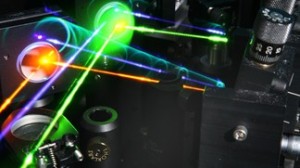Aug 29 2013
Photonics, the study of light in the broadest sense of the term, plays a major role at EPFL. Almost 30 labs focus on different aspects of photonics, like the design of lasers, construction of high-performance solar cells and development of tomorrow's telecommunications.
 © 2013 EPFL
© 2013 EPFL
What do solar cells, laser surgery and HD TV have in common? The answer is photonics: all three relate in some way to this fast-growing field of research. Photonics, or "light science," goes hand in hand with many new technologies. It underlies any technique for emitting, detecting, modulating, transmitting or amplifying optical signals. Below is a little overview of the topic, which is highlighted in a special review of EPFL's monthly publication Flash.
Light to replace electronics
The field of photonics came into its own in the 1960s, with the advent of laser technologies. Optics gradually replaced electronics in many fields, starting with specific areas like telecommunications but expanding its reach over time. Today, practically every scientific discipline relies on optics.
At EPFL, almost 30 different labs are employing photonics, with the labs divided between the Engineering Faculty (STI) and the School of Basic Sciences (SB). They deal with all kinds of researches, from fundamental studies (i.e quantum photonics) to concrete applications (i.e solar panels).
The fields concerned include metrology, optical communications, molecular detection and more - in short, photonics is everywhere. It is used for work on all scales and across the entire light spectrum. "Frankly, there are very few fields that don't involve photonics in some way," says Benoît Deveaud-Plédran, head of NCCR Quantum Photonics, "because anything involving a laser or an optical microscope is based on photonics, to take just two examples."
EPFL among the only Schools to offer an academic training
Only two Swiss schools offer Masters studies in photonics: one is the University of Applied Sciences in Buchs (St. Gallen Canton), which has a Masters in optics. The other is EPFL, with its "optics option" in the Master in microengineering and its photonics PhD. At postgraduate level, the number of photonics doctoral students at EPFL is steadily growing, with 87 PhDs in 2012 as against 7 in 2003. EPFL's Life Sciences Faculty also has a technical platform for bio-imaging and optical imaging (the PTBIOP), which makes a wide range of optical microscopes available to scientists.
Close to 8,500 jobs in Switzerland
Here in Switzerland close to 8,500 people are working in photonics. Among them, 20-25% hold a university degree (Bachelor, Masters or PhD). The field generates CHF 4.1 billion in revenue per year. Of that amount, CHF 1.5 billion relates to machines for solar cell production that are manufactured by a few large Swiss companies. The remainder is generated by small businesses, whose photonics-related activities are far more diverse: it goes from laser processing to optical measurement and imaging techniques.
Overall, it's clear that photonics is a field on the rise. As Christophe Moser of the Laboratory of Applied Photonics Devices notes, "The SwissPhotonics Counsel, which groups representatives from both academics and industry, awarded two merit scholarships for students in the optics branch of our Masters program. That just goes to show how much interest there is in the private sector for well-trained photonics engineers."
This private-sector interest isn't surprising, given that EPFL spins off one or two photonics-related startups per year on average. Some of these firms have ended up becoming leaders in their fields. Omnisens, for example, which was founded in 1999, is a global reference in optical monitoring, while Lyncée tec (founded in 2003) plays an important role in the field of digital optical microscopy and LESS (founded in 2012) is becoming more and more important in the field of screen lighting.